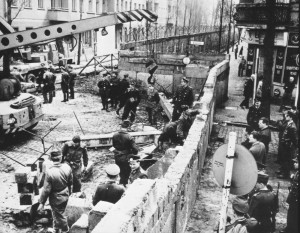SPOTLIGHT ON WORLD ANNIVERSARIES
1961 ● 50 YEARS
![]() Between 1949 and 1961, an estimated 2.5 million Germans fled from Soviet-controlled East Germany to democratic West Germany. The resultant brain drain — the emigration of skilled workers, professionals and intellectuals — prompted the East German Volkskammer (People’s Chamber) to erect a physical barrier between East and West Berlin. The Berlin Wall became a physical manifestation of the iron curtain that isolated the Eastern Bloc nations from the West. Moreover, it symbolized to the free world that Communist governments were so repressive that they had to physically contain their citizens to prevent them from leaving.
Between 1949 and 1961, an estimated 2.5 million Germans fled from Soviet-controlled East Germany to democratic West Germany. The resultant brain drain — the emigration of skilled workers, professionals and intellectuals — prompted the East German Volkskammer (People’s Chamber) to erect a physical barrier between East and West Berlin. The Berlin Wall became a physical manifestation of the iron curtain that isolated the Eastern Bloc nations from the West. Moreover, it symbolized to the free world that Communist governments were so repressive that they had to physically contain their citizens to prevent them from leaving.
 The wall was a long time coming. In the Yalta Conference of 1945, Germany was divided into zones to be shared by the Allies, with East Germany eventually controlled by the Soviets and democratic West Germany zoned by Britain, the US and France. Likewise, Berlin, the country’s capital — which was contained entirely within Soviet-controlled East Germany — was divided into a Soviet zone to the east and a British/US/French zone to the west. The Soviets installed puppet governments in East Germany and, over the next decade, closed the borders between East and West Germany; West Berlin remained an island of democracy in the middle. There was nothing to physically prevent East Germans from defecting into the free city.
The wall was a long time coming. In the Yalta Conference of 1945, Germany was divided into zones to be shared by the Allies, with East Germany eventually controlled by the Soviets and democratic West Germany zoned by Britain, the US and France. Likewise, Berlin, the country’s capital — which was contained entirely within Soviet-controlled East Germany — was divided into a Soviet zone to the east and a British/US/French zone to the west. The Soviets installed puppet governments in East Germany and, over the next decade, closed the borders between East and West Germany; West Berlin remained an island of democracy in the middle. There was nothing to physically prevent East Germans from defecting into the free city.
In 1961, Soviet premier Nikita Khrushchev gave the order, and late in the evening on Aug 12, roads and railways into West Berlin were blockaded. Thousands of East German soldiers guarded the border while workers began constructing barbed-wire fences. At about 1:00 AM, the streetlights were turned off so no one could see the construction of the wall that wrapped 96 miles around the city. In the morning, Western leaders — including President John F. Kennedy — were surprised to learn that the Berlin Wall completely surrounded the democratic half of the city, dividing families and cutting people off from their jobs. West Berliners demanded that the NATO Allies intervene, but since both the US and the USSR had stockpiles of nuclear weapons, fear of starting a war prevented any military action.
Soon afterward, the makeshift barbed-wire barrier was replaced by two rows of 15-foot-high concrete walls that proved to be virtually impenetrable. Between the two walls was a 30- to 100-yard-wide no-man’s-land, or “death strip,” patrolled by tanks and soldiers. The walls were topped with round tubes that made them difficult to grip; fortified by watchtowers armed with machine guns, sweeping searchlights and land mines; and manned by 10,000 guards.
In a famous speech in 1987, President Ronald Reagan stood near the Brandenburg Gate in West Germany and implored, “Mr. Gorbachev, open this gate. Mr. Gorbachev, tear down this wall!” Two years later, on Nov 9, 1989, the wall was finally breached by a surge of thousands of East Germans, opening the border for the first time in nearly 30 years.
During its time, an estimated 5,000 East Berliners succeeded in crossing the wall, while an equal number were detained in the process. An estimated 191 were killed trying to scale it or tunnel beneath it to freedom.
www.chases.com ● Chase’s Calendar of Events 2011